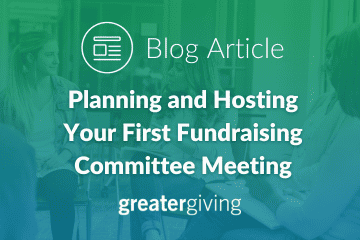
Mastering Your First Committee Meeting for a Successful Fundraising Event with Greater Giving
Organizing a fundraising event can be a thrilling endeavor, but success hinges on effective planning and collaboration. We’re here to guide you through the crucial first step: hosting a fundraising event committee meeting. Let’s delve into the key aspects of creating a productive session that sets the stage for a triumphant fundraising event.
Crafting a Fundraising Event Committee Meeting Agenda for Success
The cornerstone of any successful fundraising committee meeting is a well-structured agenda. Start by outlining the key topics that need discussion. Begin with a warm welcome and introduction, setting a positive tone for the meeting. Dive into event logistics, such as venue selection, date, and time. Allocate time for each agenda item to ensure a focused and efficient discussion.
Consider including:
- Event Overview: Provide a brief overview of the fundraising event, emphasizing its purpose and goals in the first fundraising committee meeting. Committee Roles and Responsibilities: Clarify the roles of each committee member, fostering a sense of accountability and teamwork.
- Budget and Fundraising Goals: Discuss the fundraising event budget, outlining expected expenses and revenue goals. Establish clear fundraising targets for the team to work towards.
- Marketing and Promotion Strategy: Discuss the marketing plan, including online and offline strategies to maximize event visibility.
- Timeline and Milestones: Create a timeline with key milestones to keep everyone on track. Assign responsibilities for each milestone to ensure accountability.
Defining Fundraising Event Goals
Understanding your event goals is paramount to its success. Clearly define both financial and non-financial objectives. Financial goals may include a specific fundraising target, while non-financial goals could involve community engagement, brand awareness, or partnerships.
Consider the following:
- Financial Targets: Set realistic yet ambitious fundraising goals. Break them down into manageable segments, allowing for better tracking and adjustment as needed.
- Community Engagement: Foster a sense of community by incorporating engagement goals. This could include reaching a specific number of attendees, creating memorable experiences, or establishing lasting connections with sponsors.
- Brand Awareness and Exposure: Utilize the event as an opportunity to elevate your organization’s profile. Outline strategies to maximize media coverage, social media presence, and community outreach.
What NOT to Do in Your Committee Meeting
While focusing on what to include is crucial, it’s equally important to be aware of pitfalls to avoid during your fundraising committee meeting. Steering clear of common mistakes can ensure a smooth planning process and a more successful event.
Avoiding Common Pitfalls
- Lack of Clarity: Ensure that everyone understands their roles and responsibilities. Ambiguity can lead to confusion and hinder progress.
- Overlooking the Budget: Neglecting the budget can result in financial setbacks. Regularly revisit the budget throughout the planning process to make informed decisions.
- Ignoring Marketing Strategies: Emphasize the importance of a robust marketing plan. Ignoring this aspect can lead to low attendance and decreased fundraising potential.
- Neglecting Team Dynamics: Foster a collaborative and positive environment within the committee. Address conflicts promptly and encourage open communication.
By creating a detailed agenda, defining clear goals, and avoiding common pitfalls, your fundraising committee meeting sets the stage for a successful fundraising event. With careful planning and effective collaboration, your event will not only meet but exceed its objectives. Happy planning!
